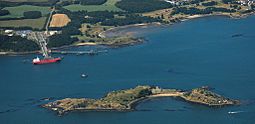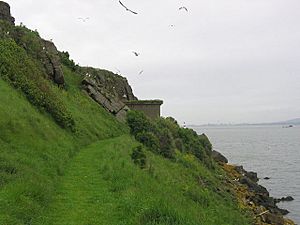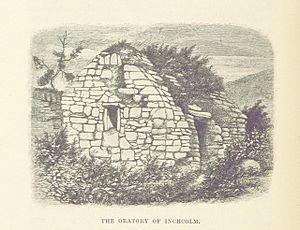Inchcolm facts for kids
| Gaelic name | Innis Choluim |
|---|---|
| Meaning of name | Island of St Columba |
 Inchcolm and Braefooot Bay |
|
| OS grid reference | NT189827 |
| Coordinates | 56°02′N 3°18′W / 56.03°N 3.30°W |
| Physical geography | |
| Island group | Islands of the Forth |
| Area | 9 hectares (22 acres) |
| Highest elevation | 34 metres (112 feet) |
| Administration | |
| Sovereign state | United Kingdom |
| Country | Scotland |
| Council area | Fife |
| Demographics | |
| Population | 2 |
Inchcolm is a small island in Scotland, located in the Firth of Forth. Its name comes from Scottish Gaelic and means "Columba's Island". This island has a long history, including being attacked by English raiders and used as a fort during both World Wars to protect nearby Edinburgh. Today, Inchcolm is a popular spot for visitors who come to see its old abbey.
Contents
Exploring Inchcolm Island
Inchcolm is in the Firth of Forth, off the coast of Fife. It sits east of the Forth Bridge and north of Edinburgh. A stretch of water called Mortimer's Deep separates the island from the Fife mainland.
The island has three main parts. The eastern side was important for military defenses during World War II. The lower central part has a small natural harbor. The larger western end is home to much of the island's wildlife. In 2001, two people lived on the island. By 2011, no one lived there permanently.
A Look at Inchcolm's Past
Inchcolm has been known by different names over time, like Emona or Innis Choluim. It might have been used by the Roman fleet long ago.
Early Days and St. Columba
The island was supposedly visited by St. Columba, an Irish missionary monk, in 567. It was named after him in the 12th century. Some believe it was an early Christian center, like a "Iona of the east." An old stone-roofed building on the island, likely a hermit's prayer room, shows how old the Christian presence is. Pieces of carved stone from the Dark Ages also prove this. A special stone called a hogback, found on the island, dates back to the late 900s.
Inchcolm is even mentioned in Shakespeare's famous play, Macbeth. In the play, a Danish king pays a large sum of money to bury his dead soldiers on "Saint Colmes ynch." This shows that Inchcolm was a special burial place, much like Iona. Burying the dead on islands was common in Scotland. It helped protect bodies from wild animals like wolves.
The Abbey's Story
Inchcolm was once home to hermits, who were people living alone for religious reasons. In 1123, King Alexander I was stuck on the island during a storm. A hermit took care of him. Because of this, King Alexander decided to build a Augustinian monastery there.
The monastery became an abbey in 1235. Its buildings, including a tall square tower, a church, and other parts, are some of the best-preserved medieval abbey ruins in Scotland. Historic Scotland now looks after these ruins, and visitors can explore them.
The channel separating Inchcolm from the mainland is called Mortimer's Deep. The story says it got its name when monks were supposed to bury a knight named Sir Alan Mortimer at the church. Instead, they threw his coffin into the sea.
Walter Bower, who was the Abbot of Inchcolm from 1418 to 1449, wrote an important historical book called the Scotichronicon.
Attacks from England
Like other islands in the Forth, Inchcolm was attacked many times by English raiders in the 14th century. This was during the Wars of Scottish Independence, when Scotland and England were fighting. The island was right in the path of ships carrying supplies or raiding parties.
In 1335, English raiders stole treasures and a statue of St. Columba from the abbey. Legend says their ship almost sank, and they believed it was St. Columba's wrath. They returned the stolen items, and then had good weather for their journey home. In 1384, another English raid tried to burn down the abbey, but strong winds put out the flames.
Later History and Fortifications
In the 16th century, Inchcolm faced more English attacks. After the Battle of Pinkie Cleugh in 1547, the English fortified the island. They built defenses and had soldiers there. However, the English commander later abandoned the island and destroyed his fortifications in 1548.
The island was also used as a prison for important people, like Archbishop Patrick Graham. Because Inchcolm is an island, its religious buildings are in better shape than many on the mainland. They were harder for people to destroy during the Protestant Reformation.
In the 16th century, the island became the property of Sir James Stewart. His family later became the Earls of Moray.
Military Defenses in World Wars
During both the First World War and the Second World War, Inchcolm was a key part of the defenses for the Firth of Forth. It was the headquarters for the "Middle defenses," which included a large anti-submarine barrier across the river. These defenses protected naval ships anchored near the Forth Rail Bridge.
In 1916-17, the defenses were made even stronger. A tunnel was built under the hill on the east side of the island. This tunnel connected new gun batteries to their ammunition storage. The engine house from the First World War, which powered searchlights, is now used as a visitor center by Historic Scotland. The island was used again in 1939 for the Second World War, and the anti-submarine barrier was put back in place. Many old military buildings from both wars can still be seen on the island.
Visiting Inchcolm Today
Today, you can take a ferry to Inchcolm island. Two ferry services, the Maid of the Forth and the Forth Belle, offer trips from South Queensferry between Easter and late October. Visitors usually get about 1.5 hours to explore the island.
The main attraction is Inchcolm Abbey, which is Scotland's most complete surviving medieval monastery. Because it was dedicated to St. Columba, it was sometimes called the "Iona of the East." The well-preserved abbey and the ruins of the 9th-century hermit's cells draw many visitors to the island.
Wildlife on Inchcolm
The western part of the island is home to many seagulls and fulmars. Seals are often seen around the island, resting on nearby rocks. There are no stoats or hedgehogs on Inchcolm, so bird eggs can often be found on the ground.
Today, two Historic Scotland staff members live on the island. They help maintain the island and run the visitor shop.
Images for kids






